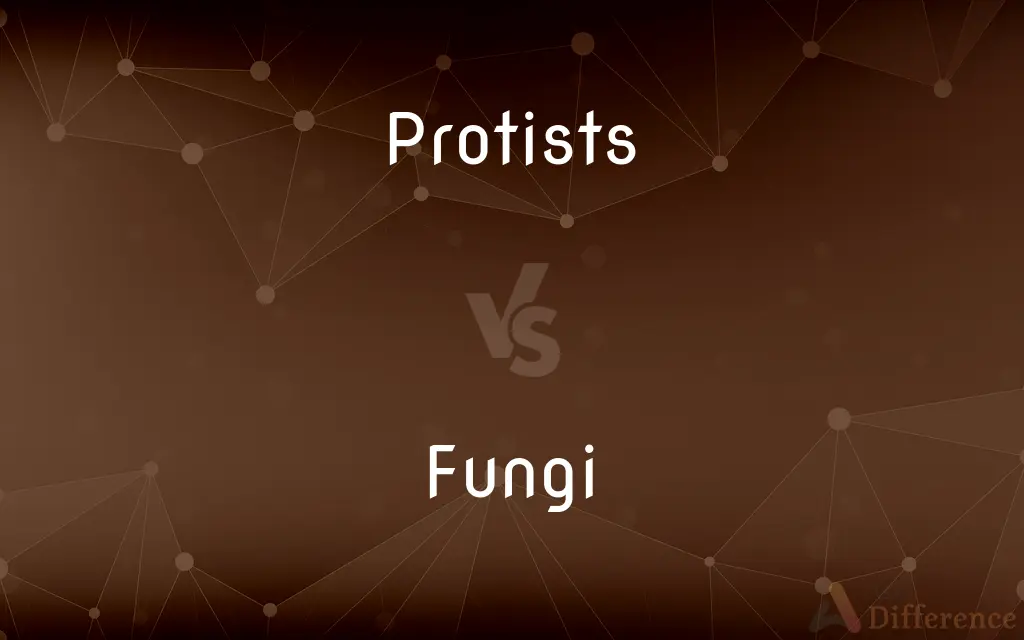Protists vs. Fungi — What's the Difference?
By Tayyaba Rehman — Published on November 15, 2023
Protists are diverse microorganisms that belong to the kingdom Protista, while Fungi are spore-producing organisms belonging to the kingdom Fungi. Both are eukaryotic but differ in structures and nutrition modes.

Difference Between Protists and Fungi
Table of Contents
ADVERTISEMENT
Key Differences
Protists encapsulate a varied group of eukaryotic organisms, most of which are unicellular and some multicellular. They live in a wide range of moist habitats, such as soil, freshwater, and marine environments. Conversely, Fungi comprise a kingdom of usually multicellular, spore-bearing organisms that lack chlorophyll and obtain nutrients through decomposition or parasitism.
Fungi exhibit a unique feeding method called absorptive nutrition, where they absorb nutrients directly through their cell walls after breaking down external organic matter with enzymes. Protists, on the other hand, exhibit diverse nutrition modes, including photosynthesis, absorption, and ingestion, attributing to their variable habitats and types.
The cellular structure of Protists is comparatively less complex than that of Fungi. While some Protists exhibit similarities to animals and others to plants, Fungi are significantly different, displaying complex networks of filaments and exhibiting chitinous cell walls, which are distinctive to their kingdom.
Reproduction in Fungi generally occurs through both sexual and asexual means, typically involving complex life cycles and the production of various types of spores. Protists also reproduce through both sexual and asexual means but tend to have simpler life cycles and reproductive strategies, given their microscopic simplicity.
In an ecological context, Protists and Fungi play vital roles in their respective environments. Protists often constitute a substantial part of the microbial community, impacting nutrient cycling and food webs. Fungi, as decomposers, are critical for nutrient recycling, breaking down dead organic material and releasing nutrients back into the ecosystem.
ADVERTISEMENT
Comparison Chart
Kingdom
Protista
Fungi
Cellular Complexity
Generally simpler, mostly unicellular
Complex, predominantly multicellular
Nutrition
Varied: photosynthetic, absorptive, or ingestive
Mainly absorptive through external digestion
Reproduction
Both sexual and asexual, generally simpler
Both sexual and asexual, can be complex
Ecological Role
Impact nutrient cycling, part of microbial community
Decomposers, vital for nutrient recycling in ecosystems
Compare with Definitions
Protists
Protists can be autotrophic or heterotrophic, depending on the species.
Photosynthetic protists, like euglena, produce their own food using sunlight.
Fungi
Fungi are eukaryotic organisms with a chitinous cell wall, reproducing via spores.
Mushrooms, a type of fungi, can be found growing on rotting wood.
Protists
Protists are typically unicellular, eukaryotic organisms found in moist environments.
Algae are protists that play a crucial role in aquatic ecosystems.
Fungi
Fungi can form mutualistic relationships with other organisms.
Mycorrhizal fungi form beneficial relationships with many plant species.
Protists
Protists can exist as free-living organisms or as parasites.
Some protists can cause diseases, such as malaria in humans.
Fungi
Fungi primarily obtain nutrients through the absorption of decomposed matter.
Fungi play a vital role in decomposing dead organic material in forests.
Protists
Protists can reproduce both sexually and asexually, depending on conditions.
Certain unfavorable conditions may induce sexual reproduction in protists.
Fungi
Fungi can be beneficial or harmful to humans and ecosystems.
Some fungi are pathogenic to plants, causing diseases that affect crops.
Protists
Protists can have animal-like, plant-like, or fungi-like characteristics.
Some protists, like amoebas, exhibit animal-like behaviors and characteristics.
Fungi
A plural of fungus.
Protists
Any of numerous eukaryotic organisms that are not fungi, plants, or animals and are chiefly unicellular or colonial. Protists that are multicellular do not have cells differentiated into tissues. The protists include the protozoans, certain algae, oomycetes, and slime molds.
Fungi
(pathology) Spongy, abnormal growth, as granulation tissue formed in a wound.
Protists
Plural of protist
Fungi
Alternative spelling of fungee
Fungi
A style of folk and popular music from the Virgin Islands, traditionally performed by bands consisting of banjo, guitar, ukulele, and washboard with various percussion instruments on rhythm.
Fungi
A group of thallophytic plant-like organisms of low organization, destitute of chlorophyll, in which reproduction is mainly accomplished by means of asexual spores, which are produced in a great variety of ways, though sexual reproduction is known to occur in certain Phycomycetes, or so-called algal fungi. They include the molds, mildews, rusts, smuts, mushrooms, toadstools, puff balls, and the allies of each. In the two-kingdom classification system they were classed with the plants, but in the modern five-kingdom classification, they are not classed as plants, but are classed in their own separate kingdom fungi, which includes the phyla Zygomycota (including simple fungi such as bread molds), Ascomycota (including the yeasts), Basidiomycota (including the mushrooms, smuts, and rusts), and Deuteromycota (the fungi imperfecti). Some of the forms, such as the yeasts, appear as single-celled microorganisms, but all of the fungi are are eukaryotic, thus distinguishing them from the prokaryotic microorganisms of the kingdon Monera.
Fungi
The taxonomic kingdom of lower plants
Fungi
(pun) the one who buys the drinks
Fungi
Fungi can reproduce through both sexual and asexual means.
Bread mold reproduces asexually, rapidly spreading on stale bread.
Common Curiosities
Are all fungi harmful to humans and plants?
No, while some fungi can be pathogenic, others can be beneficial or neutral. Some fungi form symbiotic relationships with plants, and others are used in baking and brewing.
What is the primary nutritional mode of protists?
Protists exhibit various nutritional modes, including photosynthesis, absorption, and ingestion, depending on the species.
How do fungi obtain their nutrients?
Fungi primarily obtain nutrients through absorptive nutrition, decomposing external organic matter using enzymes and then absorbing the released nutrients.
What is the role of protists in the ecosystem?
Protists play various roles, such as being primary producers in aquatic ecosystems, acting as parasites, and contributing to nutrient cycling.
Do fungi have a role in medicine?
Yes, fungi have been crucial in medicine, such as the antibiotic penicillin, which is derived from the fungus Penicillium.
Can protists be seen with the naked eye?
While most protists are microscopic, some, such as certain algae species, can be seen without a microscope.
How do fungi contribute to ecological stability?
Fungi, as decomposers, play a vital role in breaking down dead organisms and waste, releasing nutrients back into the environment and supporting nutrient cycling.
Do protists have specialized organelles?
Yes, protists, being eukaryotic, contain various specialized organelles, like mitochondria and chloroplasts in some species.
Can protists move?
Some protists, like amoebas and paramecia, can move using structures like cilia, flagella, or by amoeboid movement.
Can protists reproduce both sexually and asexually?
Yes, protists can reproduce through both sexual and asexual means, depending on the species and environmental conditions.
Are fungi plants?
No, fungi form their own kingdom and are distinct from plants, animals, and other life forms.
What is the significance of fungi in agriculture?
Fungi can be both beneficial and harmful in agriculture, where they can form symbiotic relationships with plants or act as pathogens affecting crops.
How do fungi reproduce?
Fungi can reproduce both sexually and asexually, often involving complex life cycles and producing a variety of spore types.
Can both protists and fungi be found in similar habitats?
Protists and fungi can both be found in a variety of moist habitats, but they also occupy distinct ecological niches due to their varying biological characteristics and nutritional modes.
How do protists impact human health?
Some protists are harmful to humans, acting as parasites and causing diseases like malaria.
Share Your Discovery

Previous Comparison
England vs. Great Britain
Next Comparison
Self-esteem vs. Self-efficacyAuthor Spotlight
Written by
Tayyaba RehmanTayyaba Rehman is a distinguished writer, currently serving as a primary contributor to askdifference.com. As a researcher in semantics and etymology, Tayyaba's passion for the complexity of languages and their distinctions has found a perfect home on the platform. Tayyaba delves into the intricacies of language, distinguishing between commonly confused words and phrases, thereby providing clarity for readers worldwide.














































